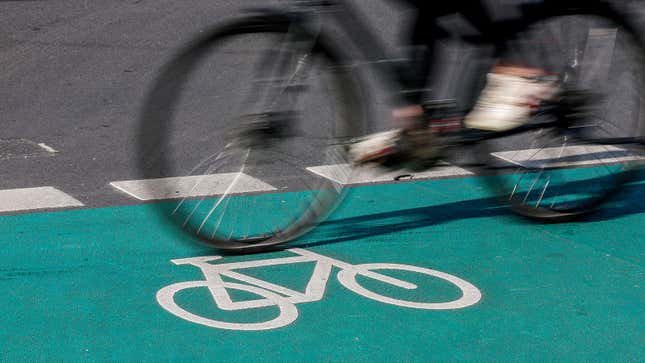The Morning Shift: Cars Should Warn You About Bikes So You Don’t Have To Look

Crash avoidance tech should warn drivers about cyclists, safety groups have warned. Photo: Drew Angerer (Getty Images)
The National Highway Traffic Safety Administration is in the midst of developing new safety measures that would mandate crash prevention tech in all new cars. Under the proposed rules, all new light-duty vehicles would require emergency braking tech like pedestrian detection. But so far, the rules don’t do anything to protect some of the most vulnerable road users: cyclists.
Forget Autonomy, Drivers Still Want Control
Now, Automotive News reports that safety group Advocates for Highway and Auto Safety argues that the decision not to include bike detection in these proposals is “glaringly missing.” The site reports:
“In 2021, traffic fatalities reached nearly 43,000, and preliminary 2022 data show there is no sign of abating,” said Cathy Chase, the group’s president.
“Tragically, bicycle deaths have risen more than 50 percent since 2010 along with a 13 percent increase in pedestrian fatalities, according to NHTSA. This carnage must stop. Common sense solutions are available, but they must be implemented.”
However, the NHTSA responded by saying that there “are currently no established test procedures” that can effectively “evaluate the crash-avoidance technology’s performance in avoiding bicycles” Automotive News added. The agency said it would “evaluate including bicycle detection in future rule-makings.”

Sure, it would be better if there were just bike lanes everywhere. Photo: Jan Woitas/picture alliance (Getty Images)
There are some positives in the NHTSA’s new crash-detection rules. If the agency’s current proposals were to be adopted, “nearly all U.S. passenger cars and trucks” would have to be fitted with crash-avoidance tech within three years. The tech could include pedestrian detection and measures that can bring a car to a safe stop in order to prevent a collision.
Before it is mandated, these measures would have to meet a “number of performance standards,” but the agency projects that such technology could “prevent at least 360 deaths and reduce injuries on U.S. roads by at least 24,000 annually.”



